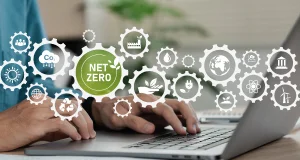Welcome to the world of Birlasoft through our very own podcast, this is Tech Lyceum, you're catching a brand new episode straight from the B Mark manufacturing series. And today's topic is connected product strategy for manufacturers. Now, what are smart connected products? What are some of the opportunities that they present? And how can they help us grow? We're lucky for us we have two very special guests who are experts in the area and are here to answer all our questions and show us the way. First up we have Sandeep Malhotra, who's the head of strategy and growth at Birlasoft. With over 27 years of global experience in business and technology. He's anchored diverse roles in strategy, consulting, business development, large deals, Practice and Technology, incubation ecosystems, development and delivery. Now we also have Advait Waghmare, who is a thought leader, and the global consulting head of the digital transformation business unit, here at Birlasoft. He's a seasoned professional to say the least with over 30 years of experience in digital strategy development, and consulting across manufacturing CPG and retail energy and life sciences, Sandeep Advait, it's great to have you join us today. And it's also great for us to be able to learn from your expertise and wisdom. So thank you, and welcome to the show.

Thank you Neerja. This is Sandeep very excited to be in this interesting podcast.
Thank you Neerja. Thanks for the opportunity to participate in this podcast today.
Absolutely. Now, my first question is coming to you, Sandeep,
Q: Let's understand the topic of conversation a little bit better with billions of connected devices globally? What exactly are smart connected products? And what are the factors contributing to the massive growth of these connected products?
Interesting question Neerja, you know, almost everything is becoming a smart connected product today, a product that can possibly be sensed, or probed, or it can be actuated or controlled, is a smart product. Now, it could be as simple as a connected refrigerator at your home that you can control from outside as a consumer. Or it could be an interesting ride in a theme park or going to a new wearing a smart glass or you're wearing a HoloLens one on your head. And as you go in through the roller coaster, you feeling as if you're going through mountains and rivers or it could be as complex as a list in an oil rich field, all of these are connected products. And then the three things that are important to for a product to be connected. One, this product has sensors and actuators these are device that can sense a product, or it can control the product. Second part of it is really a computing environment or set of microprocessors software and computing system. And third, this is real these devices are connected, they will need any type of connectivity, it could be a wide connectivity through Ethernet, it could be Wi Fi, or it could be the much awaited 5g, which is becoming quite mainstream. That's one part. Second part is, you know, these connected products can stream your ongoing data. So the product can see new data like you know about its performance, about, you know, it's about to going down. So how can you control the product to reduce the long term? What can you do to understand the current flow, start to the product and look at the user behavior and be able to improve that functionality in your R&D? Or, you know, looking at customer behavior, what else does customer want? And what can you cause? So basically, this is what is a smart product. So think of it is an intelligent product, which can communicate to way, and you can configure and change and get a lot of sense out of it. You asked about several things which are contributing to the growth of these types of products, I think one is the car today is getting commoditized. You know, it's very simple to create different types of sensors and actuators. They are widely available, they are very cheap, they're getting more cheaper and cheaper. That's one very big factor for the contribution of connector enterprises, but connected environments. The second part of it is, you know, the much awaited 5g, which is mainstream in several parts of the world, it's coming to India as well, as we all know, you know, I think it is a network, which is low latency and high performance and extremely scalable. So it can take a lot of data two ways very easily. Third is, you know, this interesting part of what I call near device computing, we call it edge computing more technically. So we have a computing environment, which is not very powerful, but still it can actually do very fast processing near to the device. Remember a think tank example that I took you in that example. That edge is talking to the roller coaster, not a lot computing environment weighed too far in the cloud. So as is very, very important in this. The third aspect is really the transformation that we're seeing in the data engineering data analytics space with AI NML coming in. So I think these are some of the factors that are driving higher value from products that are now connected to take it to the next level.
Thank you for that answer Sandeep. And clearly there are a lot of opportunities for us to explore considering, you know, how advanced this technology is, Advait, let me ask you this question,
Q: What do you think a manufacturer should do if they want to leverage this potential, and if they want to solidify the value of these connected devices, what use cases do we see across the industry.
Thanks Neerja. I think this is probably the most exciting time for a manufacturer, if you go back to early 2000, you could see a manufacturer calling for a dealer's conference. And what they will do is they would like to see a feedback on the product performance, they would like to get some customer insights. And based on these inputs, they would update the product designs are they will change the travel strategies. This you could see was a very inefficient process. What we see today is a paradigm shift in the industry. Think about it. Earlier, we had a manufacturer speak to a customer about the product. And what we see today, we have a manufacturer speaking to the product, about the customer. So this is a fundamental shift that we are seeing in the industry today. Now when we say connected products, connected products are actually creating connected customers. And they are creating connected customer experiences. They are transforming industries, they are transforming organizations, and really forcing them to re evaluate the business models and their operations. A smart connected product is providing a real time visibility for a manufacturer with their products, and creating a tremendous new market opportunities. What is important for a manufacturer is to make sure that they pick the right objectives when they you know, pursue this particular strategy. Now, they could have an objective that they want to be either driving a growth, or they could be, you know, pursuing operational excellence, or they could be, you know, trying to improve the customer experience. Or they could really be trying to create a competitive differentiator. So I think it's very important for them to baseline what their goals are, once they have been able to set up the goal, the journey really starts by creating a smart product, and then building an integrated ecosystem around it. Now, when we say integrated ecosystem, think about the connected products value chain, the value chain really rolls across five pillars, starting with product engineering, where you create a smart product, then it's about all about connectivity, so that you can get a sense of the product performances, then it's all about data insights, there is tremendous amount of data that is going to come in the ability to ingest aggregate that particular data and create insight becomes very important. And finally, it's all about the action that you can take on that particular data, which not only helps improve the experience, but also improve the asset performances. Let's discuss a few use cases. Let's say you are asset intensive organization, for example, your industrial engineering or high tech manufacturer, what is your biggest focus, your biggest focus is going to be on asset performance management. Now, if you are trying to improve the asset performance management, what you are likely to do is to build solutions, like asset tracking, it could be asset utilization, it could be asset availability. All of these are the use cases that will help you improve asset performance management. Apart from this, we are seeing use cases across industries. Let's pick up a few use cases that we see. You see connected trailers, you see connected hospital beds, you'll see connected CNC machines connected buses, connected coolers, connected healthcare connected bearings connected lightning. So the opportunities are really, really endless. So to summarize, if you are industrial manufacturer, and automotive manufacturer, high tech or med device manufacturer connected products is transforming the business process operations for each one of you.
Absolutely, it sure sounds like it and clearly there's a lot of value to the customer through these connected products.
Q: Sandeep, could you maybe tell us how these smart connected products are helping manufacturers to transform into a more customer centric service-oriented organization?
Sure Neerja. I think Advait has really explained it very well in terms of what is the opportunity for the new Viet manufacturers. What we are seeing at Birlasoft is that opportunity is becoming very different. You know, most of the manufacturing customers that we are asking He knows that we want to transform our business model, we don't want to stay with, make it, ship it and be done with it model, we want to get to a model of, which is make it Give it to me maintain and improve it. I think that's a very big paradigm shift that we're seeing, it's a great opportunity for all of us to improve. You know, there are two or three areas which are very, very interesting, you know, in this new model of subscription that that manufacturers are asking us, one of them is really after market once the product is launched in the market and consumers are using it. What how can you make, you know, that operation seamless, how can you use product status operations data, for remote monitoring, and ensuring high amount of uptime, that's not the thing of a new car that you bought, and you're driving that car, and your car is connected. So the OEM and support team are seeing your car, they are looking at various parameters. And, you know, the ad performance service on the core, which includes updates over the air without you, you will not be aware of it. I mean, it's a very unique situation, you know, it's this kind of elimination of problem. It's not just about the active proactive it is about preventive and avoidance altogether, no customer don't see the problem. Look at the amount of excellence, it'll give to that manufacturer in terms of net promoter score of that customer. The second part is really a lot of input to the R&D setup, right? As a product company, what do I wish to do as a manufacturer, I want to continue to improve. Now here in the connected product world, you're getting a lot of data about cost, performance fits usage, what is customer not liking? Where is the product hanging? What is it that they are getting retreated with? What is it that they're really enjoying, and if collect all of their data and bring some intelligence out of it, that intelligence can help your thought R&D team to come up with better version, the next version that they're planning for, in fact, you can really not just improve the version, but add to it in such a way that you can charge money for the experience that you're giving. So that's the second part of the benefit. The third part is that, you know, customer today is, is becoming more and more intelligent, you know, I just don't want what I want I wanted in my way. So I think that is where the shop floor is getting impacted. Almost every customer, you know, is asking for deep customization. And they have their own personal performances. As a buyer. That's the second part, right? So you know, how can you configure the product to be what this customers in a unique way is one element. Second element is, you know, has this product is getting manufacture, you are giving customer timely update on the delivery timeline and commitment, you're actually doing almost just in time manufacturing in just in time inventory management is part that you have to procure the configuration process that you have all can be done in a very similar special. Hence, I think, you know, a smart product is not about just the efficiency and uptime, it is also about the innovation and change that consumers are happy to get and happily pay for it. So it's a great time for manufacturer across the world to move to, you know, a much higher value for their end customers.
So Sandeep made some great points. What I'll add is that what we really like about the connected products initiative is the value that it is bringing to both the key stakeholders, the manufacturer, as well as the customer.
Definitely, I mean, it's really interesting to see in how many ways you can actually apply smart products to ultimately benefit the end user and Advait, maybe you can answer this question for us. So with multiple service providers and service integrators in the market, what is the selection criteria manufacturers should keep in mind while choosing the right digital partner for this enterprise level transformation
Absolutely Neerja. Now, this is this is very, very important point. Now, let's start with a few fundamental things that I would believe needs consideration to start with, this is a transformational journey, which has a potential to impact the business as well as operations. Thus, you need to look at somebody who can be a strategic partner. And a long term view needs to be under consideration yet. Very importantly, you need to look at a partner who understands the industry, the manufacturing industry, who understands the business model in that particular industry, understand the business processes, the regulatory requirements, the data privacy laws, okay for the region, the cybersecurity elements that get involved here. So industry knowledge and expertise becomes very, very important part, you know, from a partner standpoint. So that's the first thing. The second most critical aspect here is about the architectural competency. Now if you look at these programs, they often need a platform thinking approach which is where A unique, it requires device communication capabilities, it requires an ability to handle and process high volume data, you will often see some of these programs, okay? Having a subscription based model. So architecture becomes a very, very important element. So investing in the right architecture, which is robust, scalable, secure, and most importantly, cost effective, okay, because of the scale of the business involved here becomes very, very important. So that's the second thing. The third thing is about technology plan. So if you see we spoke about the integrated value chain earlier, what this really means is, these programs would require diverse skills across multiple technologies. So what are the technologies involved? Okay, you require experience and expertise in design thinking, you require expertise in industrial IoT technology, expertise in cloud technology, data science, customer experience, API, cybersecurity, does, what we recommend is to ensure that you look for a partner who's well rounded with skills across all of these particular technologies. And we are happy to share that at Birlasoft. We have partnered with more than 50 manufacturers, and help them create an ecosystem, which is supporting more than 500,000 products across different industries. So finally, it will be helpful to get started with a platform, which can help accelerate the connected products initiative. Okay. Birlasoft has a platform interlayer set, which we often leverage. And you can see a lot of information about it on the web. Also, the last point that I would recommend is that when you go down this particular path, it is very important to think, big, and think long term. Often we see customers starting with a pilot initiative, which is great, and which is a perfect way to get started. But very important to make sure that you have the effect that it has in the integral ecosystem environment is something that we can handle the best in the marketplace. I thought that's also important point for somebody to consider.
Excellent. I think it's really exciting to see how Birlasoft is leveraging these opportunities as well and getting ready for the future. Sandeep Advait, You've opened our minds to the potential of smart products and services today and have truly helped us understand what the future holds for us with change makers, such as yourselves leading the way. So thank you for taking the time out to share your thoughts with us. It was great having you.
Thank you Neerja, for your time.
Hey, thanks, Neerja. Thanks for the opportunity. It was a very exciting discussion. Thank you.
That was such a great episode. Now, here are some interesting facts for you to know. Birlasoft has partnered with 15 Plus manufacturers and has helped create an ecosystem with more than 500,000 connected products across industries. How cool is that? Some of those industries are industrial manufacturing, med devices, high tech and automotive and the like. Now, Birlasoft has a platform intelli asset that helps accelerate the connected products initiative. Now here's the thing smart connected products offer exponentially expanding market opportunities by augmenting manufacturers in their decision making enabling operational efficiency and reinventing strategic positioning with newer business models. So the potential is never ending and it's a whole world waiting to be tapped into. I hope you learned something new today. I'll be back with more Tech Lyceum. Until then. It's me Neerja signing off. Bye bye.




